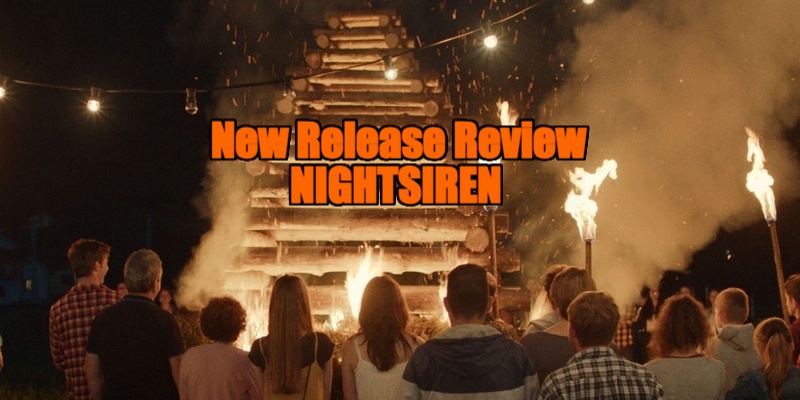
Review by
Eric Hillis
Directed by: Tereza Nvotová
Starring: Natalia Germani, Eva Mores, Juliana Oľhová, Zuzana Konečná, Marek Geišberg

Angry villagers turning on women they believe to be witches. Naked nymphs
writhing around bonfires. Women communing with snakes and wolves. An
outsider searching for answers in a tight-knit rural community where
superstition not only persists, but governs. Many of the tropes of
folk-horror are present in Tereza Nvotová's Nightsiren, but by weaving genre cliches into the fabric of real life shibboleths
held by the people of rural Slovakia, the director (collaborating with
co-writer Barbora Namerova) has created a film that will feel
simultaneously familiar to horror fans yet fresh to most western
eyes.

It's to a small hamlet in rural Slovakia that twentysomething Sarlota (Natalia Germani) returns, having received a letter from the town's mayor informing her
that she has inherited her late mother's property. A prologue details how
Sarlota fled the village as a child after accidentally causing her little
sister Tamara to fall to her death from a clifftop. Returning to a place
fraught with traumatic memories, Sarlota finds her mother's home has been
burnt to the ground, and so she decides to stay in a now empty
neighbouring cabin once occupied by Otyla (Iva Bittová), a woman
believed to be a witch by the villagers.
As is always the case in folk-horror movies of this nature, Sarlota is
met with hostility by the locals, especially when they hear she's staying
in Otyla's home. The one person who rejects such superstition is Mira (Eva Mores), a free-spirited young woman who likes to lounge naked in the moonlight
("The sun burns, but not the moon," is her reasoning. Fair enough). Mira
befriends Sarlota and the two share what initially seems like a homoerotic
bond, but morphs into something else later. Said bond draws unwanted
attention from the locals, who view the women's friendship with suspicion,
and Sarlota and Mira soon find themselves branded as witches.

The rise of feminism in the last few decades has given way to a
reevaluation of the concept of witchcraft. I don't think it's any
coincidence that the 1960s saw both the rise of bra-burning and a newfound
embracing of the occult in the western world. To identify as a witch is to
dare to poke the patriarchal bear, to embrace everything about femininity
that makes men uncomfortable. As such it's no longer acceptable to portray
witches as the stereotypical cackling hag villains of past horror films,
as to do so is to lend credence to the claims of those men who persecuted
them in times past. In recent years governments have even seen fit to
issue public apologies for the burning of "witches." This puts horror
filmmakers in a bit of a spot. Even those who wish to portray witchcraft
in a positive light are treading problematic ground, because to even
suggest that witches possess supernatural powers is to repeat the claims
of the murderous fanatics of old.
Nvotová tries to get around this by keeping the supernatural element of
her film ambiguous, but in doing so she has created a film that is often
frustrating in its lack of commitment to either fantasy or reality. There
are moments that imply Sarlota is in possession of occult powers, and
flashbacks do a little more than simply suggest Otyla had such abilities.
When the closing credits roll you're left with a lot of unanswered
questions that make you wonder if Nvotová is a wilfully unreliable
narrator or simply a sloppy storyteller.

The setting of the misty valleys of Slovakia fits this subject matter
like a teenage goth girl's black lace glove, and the landscape is captured
with a beguiling volatility by cinematographer Federico Cesca. The movie's most arresting sequence is a
hallucination (?) that sees Sarlota walk through a forest filled with
naked writhing women coated in day-glo body paint as though they were
the dancers in a James Bond title sequence. But the visual mood isn't
matched by the storytelling, which too often relies on characters
revealing relevant information through dialogue whenever it becomes
necessary to advance the story. Much of the narrative is predicated on
obfuscating a twist that no amount of fog can shroud from an alert
viewer. We know how a movie like this will climax, but Nightsiren doesn't build up to its harrowing denouement so much as decide to
arbitrarily drop it once it realises there are only 20 minutes left to
go.
For all its fantastical elements, the most disturbing scene in Nightsiren is taken from reality, as Sarlota and Mira find themselves
subjected to the Slovak tradition of "Easter whipping," a custom that
sees women soaked in water and whipped by men. It's no longer acceptable
to burn women at the stake, but cultures have found ways to persist with
their humiliation.

Nightsiren is on Arrow Player
from June 3rd.

